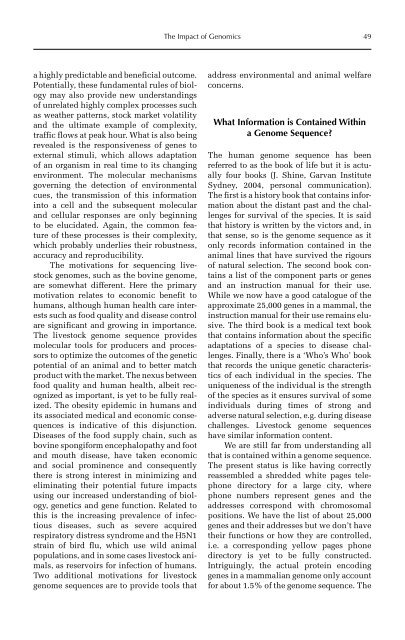Redesigning Animal Agriculture
Redesigning Animal Agriculture
Redesigning Animal Agriculture
You also want an ePaper? Increase the reach of your titles
YUMPU automatically turns print PDFs into web optimized ePapers that Google loves.
a highly predictable and beneficial outcome.<br />
Potentially, these fundamental rules of biology<br />
may also provide new understandings<br />
of unrelated highly complex processes such<br />
as weather patterns, stock market volatility<br />
and the ultimate example of complexity,<br />
traffic flows at peak hour. What is also being<br />
revealed is the responsiveness of genes to<br />
external stimuli, which allows adaptation<br />
of an organism in real time to its changing<br />
environment. The molecular mechanisms<br />
governing the detection of environmental<br />
cues, the transmission of this information<br />
into a cell and the subsequent molecular<br />
and cellular responses are only beginning<br />
to be elucidated. Again, the common feature<br />
of these processes is their complexity,<br />
which probably underlies their robustness,<br />
accuracy and reproducibility.<br />
The motivations for sequencing livestock<br />
genomes, such as the bovine genome,<br />
are somewhat different. Here the primary<br />
motivation relates to economic benefit to<br />
humans, although human health care interests<br />
such as food quality and disease control<br />
are significant and growing in importance.<br />
The livestock genome sequence provides<br />
molecular tools for producers and processors<br />
to optimize the outcomes of the genetic<br />
potential of an animal and to better match<br />
product with the market. The nexus between<br />
food quality and human health, albeit recognized<br />
as important, is yet to be fully realized.<br />
The obesity epidemic in humans and<br />
its associated medical and economic consequences<br />
is indicative of this disjunction.<br />
Diseases of the food supply chain, such as<br />
bovine spongiform encephalopathy and foot<br />
and mouth disease, have taken economic<br />
and social prominence and consequently<br />
there is strong interest in minimizing and<br />
eliminating their potential future impacts<br />
using our increased understanding of biology,<br />
genetics and gene function. Related to<br />
this is the increasing prevalence of infectious<br />
diseases, such as severe acquired<br />
respiratory distress syndrome and the H5N1<br />
strain of bird flu, which use wild animal<br />
populations, and in some cases livestock animals,<br />
as reservoirs for infection of humans.<br />
Two additional motivations for livestock<br />
genome sequences are to provide tools that<br />
The Impact of Genomics 49<br />
address environmental and animal welfare<br />
concerns.<br />
What Information is Contained Within<br />
a Genome Sequence?<br />
The human genome sequence has been<br />
referred to as the book of life but it is actually<br />
four books (J. Shine, Garvan Institute<br />
Sydney, 2004, personal communication).<br />
The first is a history book that contains information<br />
about the distant past and the challenges<br />
for survival of the species. It is said<br />
that history is written by the victors and, in<br />
that sense, so is the genome sequence as it<br />
only records information contained in the<br />
animal lines that have survived the rigours<br />
of natural selection. The second book contains<br />
a list of the component parts or genes<br />
and an instruction manual for their use.<br />
While we now have a good catalogue of the<br />
approximate 25,000 genes in a mammal, the<br />
instruction manual for their use remains elusive.<br />
The third book is a medical text book<br />
that contains information about the specific<br />
adaptations of a species to disease challenges.<br />
Finally, there is a ‘Who’s Who’ book<br />
that records the unique genetic characteristics<br />
of each individual in the species. The<br />
uniqueness of the individual is the strength<br />
of the species as it ensures survival of some<br />
individuals during times of strong and<br />
adverse natural selection, e.g. during disease<br />
challenges. Livestock genome sequences<br />
have similar information content.<br />
We are still far from understanding all<br />
that is contained within a genome sequence.<br />
The present status is like having correctly<br />
reassembled a shredded white pages telephone<br />
directory for a large city, where<br />
phone numbers represent genes and the<br />
addresses correspond with chromosomal<br />
positions. We have the list of about 25,000<br />
genes and their addresses but we don’t have<br />
their functions or how they are controlled,<br />
i.e. a corresponding yellow pages phone<br />
directory is yet to be fully constructed.<br />
Intriguingly, the actual protein encoding<br />
genes in a mammalian genome only account<br />
for about 1.5% of the genome sequence. The










